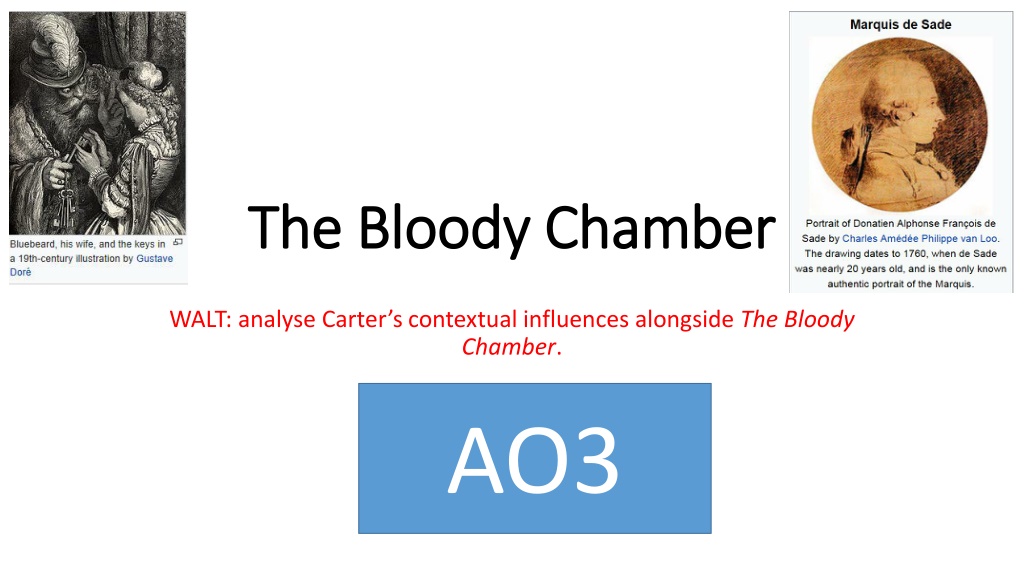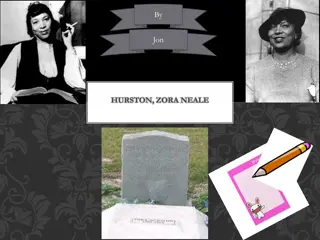Angela Carter and Her Influential Works: A Contextual Analysis
Angela Carter, an English novelist known for her feminist and magical realism works, was influenced by her personal experiences and feminist ideologies. Her notable works include "The Bloody Chamber" and "The Sadeian Woman and the Ideology of Pornography". Carter's unique perspective on women's roles and desires is reflected in her writings, challenging traditional narratives. Through her literary contributions, she reimagines fairy tales and explores themes of empowerment and self-awareness.
Download Presentation
Please find below an Image/Link to download the presentation.
The content on the website is provided AS IS for your information and personal use only. It may not be sold, licensed, or shared on other websites without obtaining consent from the author. Download presentation by click this link. If you encounter any issues during the download, it is possible that the publisher has removed the file from their server.
Presentation Transcript
The Bloody Chamber The Bloody Chamber WALT: analyse Carter s contextual influences alongside The Bloody Chamber. AO3
Angela Carter Angela Carter The Bloody Chamber The Bloody Chamber Context Context
Angela Carter Angela Carter Angela Olive Carter-Pearce (n e Stalker; 7 May 1940 16 February 1992) who published as Angela Carter, was an English novelist, short story writer and journalist, known for her feminist, magical realism, and picaresque works. In 2008, The Times ranked Carter tenth in their list of "The 50 greatest British writers since 1945". In 2012, Nights at the Circus was selected as the best ever winner of the James Tait Black Memorial Prize.
Carter Biography Carter Biography Carter was evacuated as a child to live in Yorkshire with her maternal grandmother. As a teenager she battled against anorexia. After attending Streatham and Clapham High School, in south London, she began work as a journalist on the Croydon Advertiser,following in the footsteps of her father. Carter attended the University of Bristol where she studied English literature. She married twice, first in 1960 to Paul Carter, divorcing in 1972. In 1969, she used the proceeds of her Somerset Maugham Award to leave her husband and relocate for two years to Tokyo, where she claims in Nothing Sacred (1982) that she "learnt what it is to be a woman and became radicalised". In 1979, both The Bloody Chamber, and her influential essay, The Sadeian Woman and the Ideology of Pornography, appeared. In the essay, according to the writer Marina Warner, Carter "deconstructs the arguments that underlie The Bloody Chamber. It's about desire and its destruction, the self-immolation of women, how women collude and connive with their condition of enslavement. She was much more independent-minded than the traditional feminist of her time."[7]
Carter Carter Other Works Other Works - - The and the Ideology of Pornography and the Ideology of Pornography The Sadeian Sadeian Woman Woman The Sadeian Woman and the Ideology of Pornography is a 1978 non-fiction book by Angela Carter. The book is a feminist re- appraisal of the work of the Marquis de Sade, who had been criticized by earlier feminist theorists such as Andrea Dworkin. Carter sees de Sade as being the first writer to see women as more than mere breeding machines, as more than just their biology and, as such, finds him liberating.
Carter Quotes Carter Quotes My intention was not to do 'versions' or, as the American edition of the book said, horribly, 'adult' fairy tales, but to extract the latent content from the traditional stories.
Bloody Chamber and other short stories Genre: Magical realism
The Bloody Chamber Context The Bloody Chamber Context Plot adapted from Charles Perrault Le Barbe Bleu 1697 AO2 - Parodies linguistic style of erotic literature (written by men sexual awakening of a young girl) pounding heart mechanical phallic imagery great pistons ceaselessly thrusting AO2 - Detached narrative style First part of story: metaphor for physical and emotional journey of character the guessable country of marriage. intertextual echo of Hamlet s undiscovered country (sex, marriage and death)
Bloody Chamber Styles and Themes Angela Carter's short stories challenge the way women are represented in fairy tales, yet retain an air of tradition and convention through her voluptuously descriptive prose. For example, in the opening tale "The Bloody Chamber" which is a retelling of Bluebeard, Carter plays with the conventions of canonical fairy tales; instead of the heroine being rescued by the stereotypical male hero, she is rescued by her mother. Carter effectively draws out the theme of feminism by contrasting traditional elements of Gothic fiction which usually depicted female characters as weak and helpless with strong female protagonists.By contrasting the barren and horrific atmosphere found typically within the Gothic to the strong heroines of her story, Carter is able to create sexually liberated female characters that are set against the more traditional backdrop of the fairy tale. In doing so, Carter reinvents the outdated conventions of fairy tales and offers insight on the archetypes and stereotypes of women in these well-known and celebrated stories. The stories deal with themes of women's roles in relationships and marriage, their sexuality, coming of age and corruption. Stories such as "The Bloody Chamber" and "The Company of Wolves" explicitly deal with the horrific or corrupting aspects of marriage and/or sex and the balance of power within such relationships. Themes of female identity are explored in the "Beauty and the Beast" stories such as "The Tiger's Bride". In one instance, Beauty: the story's heroine, is described as removing the petals from a white rose as her father gambles her away, a seeming representation of the stripping away of the false layers of her personality to find her true identity; an image that finds a mirror in the story's fantastical conclusion. As a whole, The Bloody Chamber can be treated as a collection of short stories that speak to a bigger narrative that deals with issues of feminism and metamorphosis instead of a set of individual tales. Although each particular narrative deals with a different set of characters, the 'oppressed female seeking liberation' is a common theme and concept that is explored throughout the collection. The characters seem to blend into each other and become indistinguishable from one another when recognising this theme in the text. The stories are updated to more modern settings. The exact time periods remains vague, but they are clearly anchored intentionally. For example, in "The Bloody Chamber" the existence of transatlantic telephone implies a date 1930 or later. On the other hand, the mention of painters such as Gustave Moreau and Odilon Redon, and of fashion designer Paul Poiret (who designs one of the heroine's gowns) all suggest a date before 1945. "The Lady of the House of Love" is clearly set on the eve of the First World War, and the young man's bicycle on which he arrives at the tradition-bound vampire's house is a symbol of the encroaching modernity which fundamentally altered European society after 1914.
Gothic Genre Gothic Genre Context (AO3) Context (AO3)
Gothic Historical Context Gothic Historical Context The Goths, Visigoths and Ostrogoths were Germanic tribes that ransacked Rome and ravaged the rest of Europe in the 3rd, 4thand 5thcenturies By the 18thcentury in England, the word Gothic had become synonymous with the Middle Ages a disfavour able period perceived as chaotic, unenlightened and superstitious. This negative perception could have been influenced by key historical events labelled as Crisis of the Middle Ages, such as: The Great Famine of 1315-1317 The Black Death: depopulation and social unrest Peasants Revolt in France Hundred Years War Endemic Warfare (tribal conflicts) Western Schism (split in the Catholic church due to three men simultaneously claiming to be the true pope))
AO2 AO2 - - Metonymy Metonymy Metonymy is a figure of speech in which a thing or concept is referred to by the name of something closely associated with that thing or concept.
Typical Gothic characteristicscharacter and Typical Gothic characteristics character and setting? setting? Gothic Archetypal Characters Young female heroine and older male villain Male villain often symbolises power and persecution beyond reason or morality (Fred Botting) Male beyond law, reason, social restraint; gives free reign to cruel and selfish desire, ambition, violent moods and intentions Female Damsel in distress - symbolises vulnerability, powerlessness, innocence, fear Gothic Setting Their conflict echoed by setting and landscapes, often far away from civilised world, isolated from reason, law and civilised authority No protection from terror stimulates irrational fears and fantasies; manifests itself here literally in the bloody chamber ; torture and depravity at the heart of opulence and riches Character Traits Transgression; pleasure increased by sanctions imposed
Gothic Conventions Gothic Conventions blood as visual spectacle and genealogy / ethnicity spectral or grotesque figures, lurid symbols creepy or startling sounds, screams in the night, groans from unknown rooms Fascination with the senses Exterior setting permeates interior Ancestral Curses Priests/monks haunted houses / castles / woods / mazes / labyrinths / ruins closed doors & secret passages / rooms light and dark interplay with shades of grey or blood-red colors (AO2 - color code) fair & dark ladies twinning, doubling, & doppelgangers repressed fears & desires; madness memory of past crime or sin Sleep, death/dream-like states death & decay Anti-hero - bad-boy Byronic heroes (typically rebellious, arrogant, anti-social or in exile, and darkly, enticingly romantic.)
Gothic Architecture Gothic Architecture
Gothic Architecture Gothic Architecture Gothic architecture is a style of architecture that flourished in Europe during the high and late medieval period (11th-15thcentury 1000-1500. It evolved from Romanesque architecture and was succeeded by Renaissance architecture. Features of Gothic Architecture the pointed arch; the ribbed vault; narrow spires; intricate traceries and the flying buttress. Pointed Arches Pointed Arches Narrow spires Ribbed Vault Flying Buttress Stained glass windows Intricate traceries Gothic architecture is most familiar as the architecture of many of the great cathedrals, abbeys and churches of Europe. It is also the architecture of many castles, palaces, town halls, guild halls, universities and to a less prominent extent, private dwellings, such as dorms and rooms.
Gothic Settings Gothic Settings
Setting Setting - - France France The Bloody Chamber is set during the Third Republic in France, a period synonymous with corruption, decadence and defeat. La Troisieme Republique began following the collapse of the Napoleonic imperialism in 1870, and the politically unstable situation saw the rise and fall of the Paris Commune (1871).
Blue Beard Blue Beard the original story the original story A very wealthy (but unattractive) aristocrat, Bluebeard, marries a young girl. He then goes away, leaving her the keys to his chateau. She enters a room she has been forbidden to visit and discovers her husband s previous three dead wives. She re-locks the door but the key is bloodstained. Bluebeard returns and threatens to kill her, but her brothers arrive, kill Bluebeard and rescue her. She remarries and shares her wealth with her family. - What do you think the moral of this story was supposed to be? What do you think Carter might have found unpalatable about this story? - reproof of curiosity
Bluebeard is sometimes the name given to the English pirate Edward Teach (c. 1680-1718), who was also known as Although he is thought to have had around 14 wives, this eighteenth century privateer was not known as a pirate when Perrault s tale was published. The two legends have been confused and sometimes deliberately blurred by various writers. Blackbeard.
Laura Mulveys Theory of The Male Gaze Mulvey then moves on to explain the term scopophilia which was developed by Freud to describe the pleasure in looking which is associated with sexual drives although nothing whatsoever to do with the erotogenic zones. In Freud's early work: ...he associated scopophilia with taking other people as objects, subjecting them to a controlling and curious gaze. (ibid p 307). Mulvey is careful to note that for Freud scopophilia was essentially active, indeed it was an activity which he associated with children who have a voyeuristic curiosity to see the forbidden areas of the body. It is a curiosity which extends to the question of the presence / absence of the penis and ultimately in Freudian method to the question of the primal scene. This pleasure in looking becomes a part of the human subject. At its extreme it can be a perversion in which sexual satisfaction can only come : ...from watching, in an active controlling sense, an objectified other. (ibid p 307) Mulvey then notes that on the surface little could be further away from the shifty voyeur eying up an unwitting victim than cinema. this is why it is important to analyse carefully the workings of the cinema as a system, part of an overall ideological apparatus which structures a particular patriarchal world as 'normal'.
Jacques Derrida: The Theory of the Other Otherness often provokes a paradoxical response in the viewer: fascination and repulsion. This contrary response allows Gothic writers to explore the liminal. Liminal can be defined as relating to a transitional stage, or a space that is between or on the threshold of two boundaries. Gothic texts often seek to collapse these boundaries or oppositions (e.g. good and evil, beautiful and ugly, human and inhuman). This creates uncertainty and raises questions about the nature of these boundaries.
Marquis de Sade Marquis de Sade Donatien Alphonse Fran ois, Marquis de Sade (2 June 1740 2 December 1814) was a French aristocrat, revolutionary politician, philosopher, and writer, famous for his libertine sexuality. His works include novels, short stories, plays, dialogues, and political tracts; in his lifetime some were published under his own name, while others appeared anonymously and de Sade denied being their author. De Sade is best known for his erotic works, which combined philosophical discourse with pornography, depicting sexual fantasies with an emphasis on violence, criminality, and blasphemy against the Catholic Church. He was a proponent of extreme freedom, unrestrained by morality, religion, or law. The words sadism and sadist are derived from his name. De Sade was incarcerated in various prisons and an insane asylum for about 32 years of his life: 11 years in Paris (10 of which were spent in the Bastille), a month in the Conciergerie, two years in a fortress, a year in Madelonnettes Convent, three years in Bic tre Hospital, a year in Sainte-P lagie Prison, and 12 years in the Charenton asylum. During the French Revolution he was an elected delegate to the National Convention. Many of his works were written in prison.
Sadism Sadism Sadism is a term given to a number of practices, associated with the Marquis de Sade, that share characteristic of deriving pleasure from inflicting pain on someone else. Sade critiqued the genre in the preface of his Reflections on the novel (1800) stating that the Gothic is "the inevitable product of the revolutionary shock with which the whole of Europe resounded".
Snow Child Overview Snow Child Overview Form: Vignette - a short impressionistic scene that focuses on one moment or character and gives a trenchant impression about that character, an idea, setting, and/or object. It's a short, descriptive passage that's more about evoking meaning through imagery than it is about plot. Etymology: The word vignette means "little vine" in French, and the name of the literary form comes from the drawings of little vines that nineteenth-century printers used to decorate the title pages and beginnings of chapters

















































